Letters from Lodi
An insightful and objective look at viticulture and winemaking from the Lodi
Appellation and the growers and vintners behind these crafts. Told from the
perspective of multi-award winning wine journalist, Randy Caparoso.
The nitty-gritty on Lodi’s seven American Viticultural Areas (AVAs)
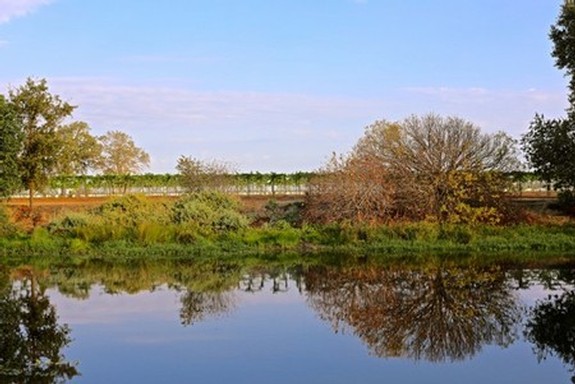
Beautifully restored riparian environment showing classic San Joaquin Series soil (a clay alluvium, and also the official state soil of California) in LangeTwins Family Vineyards' Jahant AVA estate
Why sub-divide a region by smaller AVAs?
In August 2006, when the TTB (Alcohol and Tobacco Tax and Trade Bureau) approved the usage of seven new American Viticultural Areas (a.k.a. AVAs) within the broader Lodi AVA (originally established in 1986), the question in the minds of a lot of people among the wine industry, the media and consumers was: why?
Isn’t getting anyone to recognize Lodi as an existing wine region hard enough, without complicating the matter with seven more sub-regions?
The question is legitimate. Then again, so is the answer – the reasons for establishing the Lodi sub-appellations even if, in the beginning, they are unfamiliar to just about everyone outside the growers who actually work these vineyards.
The first reason is historical: Because the best and most recognizable wine regions in the world are all defined by multiple appellations based upon differences, from subtle to drastic, in climate, soil, topography, etc.

Redding Series soil (reddish clay/cobble) in Bokisch Vineyards' Terra Alta Vineyard (Clements Hills AVA)
Take, for instance, France’s famous Burgundy region, which is divided into 44 villages controlled by their “appellations of origin” (the French system of geographical certification known as Appellation d'Origine Contrôlée, or AOC); each defined by physical differences in growing conditions that make them slightly different from the other. Within these villages are over 500 recognized vineyards (or climats) which, like Burgundy’s villages, are delineated by precisely defined boundaries that have gone unchanged for centuries. You cannot take grapes from, say, the commune of Meursault and put them into wines bottled as Puligny-Montrachet, even though the two villages are right next to each other and you may own properties in both (which many producers do).
Taking it further: Within the Burgundian commune of Puligny-Montrachet there are a total of 21 vineyards; some of these vineyards having as many as 40 owners, each managing their own tiny parcel. Wines made from the vineyard called Chevalier-Montrachet (totaling 17.5 acres) may not be lawfully bottled by the name of the adjoining vineyard, Bâtard-Montrachet (27.4 acres), and vice-versa. You could blend the two together, but you would have to call it “Puligny-Montrachet,” a village name that usually fetches a lower price than the single-vineyard wines. In Burgundy – as in the rest of France controlled by AOC regulations – location is everything, and names are sacrosanct. Why? Because characteristics of the country’s finest wines are tied directly to the growing conditions of where they are grown – a concept better known as terroir, or “sense of place.”

Fine loamy sand with wildlife footprints (field mice, bird and deer) in McCay's Lot 13 Vineyard (east side of Mokelumne River AVA)
Therefore, if Lodi was ever to begin to be considered a region worthy of any degree of respect or prestige, establishment of sub-regions based upon terroir-related distinctions had to come sooner than later. The Napa Valley Viticultural Area, for instance, consists of 16 different sub-AVAs. You can ask the same question – why? Isn’t saying “Napa Valley” good enough? But if you ask a Cabernet Sauvignon producer in Napa Valley’s Coombsville AVA, he/she would tell you that Coombsville Cabernet Sauvignons are significantly different from Cabernet Sauvignons from, say, the Rutherford, Howell Mountain, Calistoga or Los Carneros AVAs; and in fact, the soil types, aspects of slopes, elevations and climate zones differ drastically among those sub-AVAs. Of course, these Napa Valley Cabernet Sauvignons come out different; and it’s silly to expect them to taste, or be rated (attention wine critics!), the same way. Consumers have the right to know these distinctions.
The second reason for sub-dividing a region like Lodi – with, by far, the largest number of wine grape acreage in the U.S. (more than Napa Valley and Sonoma County combined) – was, of course, because of the reality of terroir-related differences that effect the morphology of plants and grapes, growing and winemaking decisions, and ultimately characteristics of wines. Right now many consumers, and much of the media and trade, may not quite grasp those differences. But that doesn’t mean they don’t exist. And what is authenticity, if not acknowledgement of the truth behind vineyards, vines, grapes and wines?
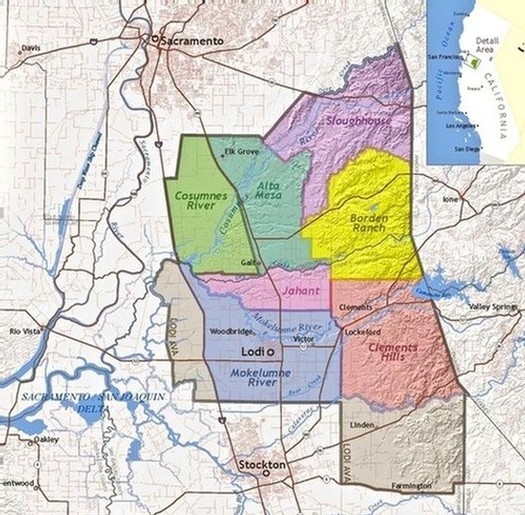
The Seven Lodi AVAs
So here’s how the establishment of Lodi’s seven AVAs went down: In August 2005 a group called the Lodi American Viticultural Areas (LAVA) Steering Committee submitted a petition to the TTB to recognize the following sub-appellations based upon distinctions primarily having to do with differing soils and topographies, more subtle climate-related differences, plus additional evidence demonstrating precedent in terms of historic usage of the proposed place names within each respective region. The seven additional Lodi AVAs approved in August 2006:
Alta Mesa
Borden Ranch
Clements Hills
Cosumnes River
Jahant
Mokelumne River
Sloughhouse
A copy of the original 2005 petition can be found in the National Archives of the Federal Register; online on this page.

Snapshot of Clements Hills AVA's combination of hills, slopes and flats planted to grapes, row crops and orchards (against a backdrop of the Sierra Nevada to the east)
The process of carving out new Lodi AVAs began in the summer of 2001, and from the beginning it involved both growers and producers. The conversation was sparked when Lodi grower Keith Watts (Keith Watts Vineyards) and Bokisch Vineyards’ Markus Bokisch began thinking of ways to highlight the differences between the volcanic soils in what was to become the Clements Hills AVA with surrounding areas in the Lodi. Bokisch and Watts organized a committee and began consulting with numerous longtime Lodi growers. They also hired Deborah Elliot-Fiske, a Professor Emeritus at U.C. Davis, to help sort out climatic and soil characteristics in unimpeachable scientific fashion.
In a story entitled Why Form an AVA? published in the October 2006 issue of Wines & Vines, a wine industry magazine, Bokisch was quoted to say that the original draft of the application for the seven AVAs was about 230 pages long, and included detailed data on the climate, soils and histories of the proposed regions. According to the magazine, “Bokisch estimated that the group spent between 1,200 and 1,800 hours preparing the application,” and “about $30,000 was collected to fund the research and applications.”

25-ft. pit dug beneath classic Mokelumne River AVA vines (Bechthold Vineyard Cinsaut, planted 1886) showing deep, consistent Tokay sandy loam soil, lacking gravel or immediate hardpan
Added Bokisch: "The greatest benefit of the use of the new AVA names will be to the consumer. It will help educate the consumer on the diversity of this region, not its homogeneity.” When asked if the new sub-AVAs might take something away from focus on the broader Lodi AVA, Bokisch was quoted to say he didn’t think so. “A person who buys a ripe, delicious Mokelumne River Zinfandel will have no doubt as to the Lodi terroir it is grown on... sub-appellations only serve to synergistically support the larger AVA they fall under.”
To alleviate fears that usage of sub-AVAs might weaken the hard-won recognition of “Lodi” on wine labels, the petition committee advocated the use of conjunctive language – meaning, names of sub-AVAs placed next to the name of the broader AVA (e.g. "Clements Hills-Lodi" or "Borden Ranch-Lodi"). While Bokisch Vineyards and other Lodi based wineries have since faithfully adhered to this principle, getting wineries based outside the region to do the same has been challenging. Hence, it is not uncommon to see, say, “Mokelumne River,” “Clements Hills” or “Borden Ranch” used on a label without reference to Lodi. Clearly, some wineries feel that labels that leave out “Lodi” may make a better impression on consumers or media. All the same, the TTB requires that at least 85% of any American grown wine must come from any AVA indicated on a label.
The general features of each AVA summarized by the LAVA Steering Committee in the original petition, which included comparisons of growing season temperatures and Storie Index ratings of soil vigor:

And further details on the seven American Viticultural Areas of Lodi:

Cosumnes River AVA
• Located mostly in Sacramento County; consisting of 54,700 acres, with the smallest amount of planted wine grapes (about 3,500 acres) of Lodi’s seven sub-AVAs; bordered on the west and east sides by Interstate 5 and California Hwy. 99.
• Named for the Cosumnes River which flows down from the Sierra Nevada to join with the Mokelumne River to mark the southwest corner of the AVA, between Walnut Grove and Thornton; and also, in the vicinity, the 1,450-acre Cosumnes River Preserve.
• The AVA’s immediate proximity to Delta fog and near-sea level elevations (5' to 48') make this one of Lodi’s cooler climate appellations (along with Mokelumne River and Jahant to the south).
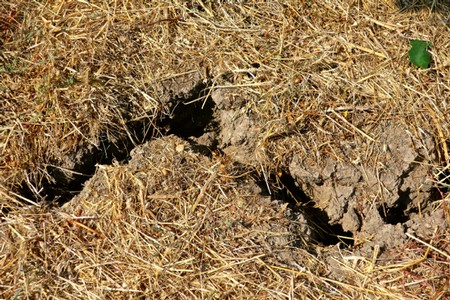
Hardened, cracking clay surface in Schatz Farms' Cosumnes River AVA vineyard
• Dominated by younger, organic, moderately fertile, silty, alluvial soils in lower areas consisting of floodplains, sloughs and wetlands; while intermediate age, reddish gravelly clay loam soils in the San Joaquin Series (also classified as Abruptic Durixeralfs) with more water-holding capacity, but also a tendency to harden and compact at the surface during the dry summers, are found in the remaining 40% of the AVA.
• The cooler Delta influences of this west side AVA have proven exceptionally friendly to white wine varieties (particularly Chardonnay, Sauvignon blanc, Pinot grigio, Vermentino) as well as reds (Cabernet Sauvignon, Merlot, Syrah).
• Excellent examples of Cosumnes River grown wines include Peltier Winery "Black Diamond" Vermentino and Peltier Winery "Black Diamond" Sauvignon Blanc.

Alta Mesa AVA
• AVA consisting of 55,400 acres with about 5,300 acres of planted grapes.
• Located just east of the Cosumnes River AVA, north of Dry Creek, and falling completely within Sacramento County.
• Name comes from the Spanish phrase (alta mesa, or “high table") that the petition explained was commonly used by local ranchers, farmers and vintners for the area to describe the region’s tabletop or mesa-like topography (ranging from 35’ on the western edge to 135’ in the east) and hence, numerous local landmarks such as Alta Mesa Rd., Alta Mesa Farm Bureau Hall (listed on the National Register of Historic Places), Alta Mesa Community Hall, Alta Mesa Fair, Alta Mesa Dairy, and Alta Mesa Gun Club.
• Fairly flat topography of intermediate elevation river terraces and alluvial fan deposits built up by the American and Cosumnes Rivers; consisting primarily of dense, reddish, gravelly clay loam soils primarily in the San Joaquin Series, with fairly shallow (2' to 5'), loose topsoil on fairly thick hardpan layers, requiring extensive deep ripping before planting.

Dropped Tannat grapes on clay-alluvium San Joaquin Series soil in Silvaspoons Vineyards (Alta Mesa AVA)
• Prairie environment; climate influenced by Delta breeze, with less wind and marginally higher temperatures than the lower lying AVA (Cosumnes River) to the immediate west.
• Initial plantings relied heavily on standard red wine varieties (Cabernet Sauvignon, Merlot, Malbec, Syrah, Cabernet Franc, Primitivo/Zinfandel); then diversified to include a good number of alternative varieties (Verdelho, Vermentino, Albariño/Alvarinho, Grenache blanc, Moscato Giallo, Torrontés, Tannat, and black skinned Port grapes such as Touriga Nacional, Touriga Francesa, Tinta Roriz/Tempranillo, Tinta Cão, Souzão, Alvarelhão and Tinta Amarela).
• Excellent examples of Alta Mesa grown wines include Fields Family Wines Delu Vineyard Vermentino, Fenestra Winery Silvaspoons Vineyards Verdelho, Wise Villa Winery Torrontés, Uvaggio Primitivo, Jeff Runquist Silvaspoons Vineyards Touriga, Jeff Runquist Silvaspoons Vineyards Tannat, and PRIE Vineyards Silvaspoons Vineyards Mencía.

Sloughhouse AVA
• Located entirely within Sacramento County at the northeast corner of the Lodi AVA; comprising 78,800 acres with about 8,000 acres of planted grapes.
• Named after the unincorporated community in the area named Sloughhouse, founded by Jared Sheldon in the 1850s; originally serving as a hotel, inn and stagecoach station along a slough of the Cosumnes River (hence the name, "Slough House," historically applied to other markers in the area), and now registered as California Historic Landmark 575.
• A higher (for Lodi) elevation, naturally woodland environment; generally over 100’ and reaching 590' near borders of El Dorado and Amador County lines, in the lower Foothills of the Sierra Nevada.
• Soils consist of older (averaging 500,000 years), lower vigor alluvial fans; much of it depleted reddish-orange, volcanic gravelly loam in the Redding Series, as well as Corning, Pentz and Hadlesville soils (all of lower vigor); with both sandier loams and increased river rock slopes on the hilltops in the vicinity of Deer Creek and Cosumnes River skirting the AVA’s north edge.

Petite Sirah growing in extreme cobble clay soil of Sloughhouse AVA, at about 120' elevation in Ironstone Vineyards' Teichert Ranch
• Cooler winters result in later bud break (up to two weeks) than the rest of the Lodi AVA; and during the growing season, this region experiences both the warmest days and cool 49° night temperatures (adding up to averages of 200 total growing degree-days more on the Winkler Scale than Alta Mesa to the west, and 300 more degree-days than Borden Ranch and Clements Hills to the south); plus Lodi’s highest annual precipitation (23 inches) and, unlike Lodi AVAs to the west, very little fog.
• Red varieties are common here (particularly Cabernet Sauvignon, Cabernet Franc, Merlot, Petit Verdot, Petite Sirah, Primitivo/Zinfandel, Grenache, Mourvèdre, Tannat, Teroldego), although there are extensive plantings of Chardonnay and Sauvignon blanc, as well as Muscat varieties.
• Excellent examples of Sloughhouse grown wines include Ironstone Vineyards Petite Sirah, Ironstone Vineyards Cabernet Franc, and Bokisch Vineyards Sheldon Hills Vineyard Monastrell.

Borden Ranch AVA
• An east side AVA located just south of the Deer Creek Hills regional park; bisected by Dry Creek just south of the center, with land in both Sacramento and San Joaquin Counties.
• Comprising 70,000 acres, with over 12,000 acres of planted grapes.
• The evidence for the commonly used name submitted to the TTB cited the founding of Borden Ranch in 1864 by Ivey Lewis Borden, which became a well known breeding ranch for thoroughbred racing horses and Hereford cattle.
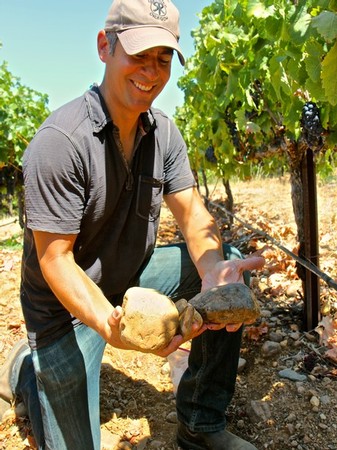
Neyers Vineyards winemaker Tadeo Borchardt demonstrating the rocky Borden Ranch AVA cobble in Zinfandel block of Bokisch's Vista Luna Vineyard
• A naturally prairie mound environment with high ridges (73’ elevation on west end, up to 520’ at the eastern edge); warmer and wetter than AVAs to the west (Alta Mesa and Cosumnes River), while receiving more wind than adjoining east side AVAs (Sloughhouse and Clements Hills).
• Hillside soils include very old (from 125,000 to 700,000 years) volcanic mud flow and alluvial stream deposits from Laguna Creek and Dry Creek, dominated by metamorphic cobble, stony clay pan and clay loam soils.
• Clay-content Durixeralf soils – which include Redding, Hicksville, Corning and Yellowlark Series soils – combine with high winds (resulting from Delta breezes from the west and cold air drainage from the Sierra Foothills to the east) to create high irrigation deficit and evapotranspiration conditions, further restricting vine vigor.

McManis Family Vineyards' Sierra Loma Vineyard, epitomizing the rocky clay hillside terroir of Lodi's Borden Ranch AVA
• The area’s hillside topography also offer multiple slope aspects and exposures; favoring a predominance of red wine varieties that are enhanced by elevated phenolic content (particularly anthocyanin and tannin) such as Cabernet Sauvignon, Merlot, Malbec, Petit Verdot, Syrah, Petite Sirah, and Primitivo/Zinfandel; although quite a bit of Chardonnay, Pinot grigio, Sauvignon blanc and alternative whites (Verdejo, Verdelho, Garnacha blanca) are also doing well here.
• Excellent examples of Borden Ranch grown wines include Bokisch Vineyards Clay Station Vineyard Verdejo, Bokisch Vineyards Vista Luna Vineyard Garnacha Blanca, Onesta Wines Clay Station Vineyard Grenache Blanc, Leaf and Vine Winery Vista Luna Vineyard Albariño, Neyers Vineyards Vista Luna Vineyards Zinfandel, McManis Family Vineyards Cabernet Sauvignon, and Noble Vines (by Delicato Family Vineyards) Clay Station Vineyard “337” Cabernet Sauvignon.

Clements Hills AVA
• South-east side AVA located entirely within San Joaquin County; comprising 85,400 acres, and the largest planting of wine grapes (21,700 acres) outside of Mokelumne River.
• Named for the census-designated community of Clements located in the northern part of the AVA; founded by Thomas Clements in 1857, and thereafter became combined with the area’s hilly terrain to coin the common local parlance, “Clements Hills.”
• The AVA’s rolling and rounded hillside topography sits on elevations ranging from 100' to 450'; bisected at the north end by the Mokelumne River, flowing down from the Sierra Nevada.
• Climate is warmer (by yearly averages of 100 growing degree-days) and wetter than AVAs to the immediate west (Mokelumne River and Jahant), while receiving slightly more cooling influence compared with other east side AVAs (Borden Ranch and Sloughhouse). Consequently, as in Lodi’s other two east side AVAs, this area experiences slightly wider diurnal swings (warmer in day, cooler at night) during the growing season.
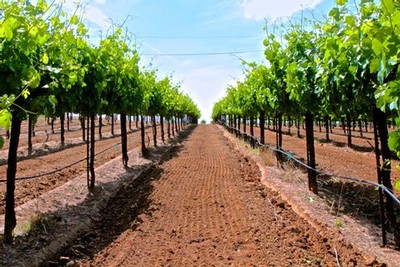
Petite Sirah growing in the deeper red Redding Series clay slopes of Clements Hills' Anaya Vineyards
• More varied topography than other AVAs; with slopes and terrace tops providing a diversity of microclimates and aspects, consisting of older soils (at least 250,000 years old) and volcanic sediments creating a naturally woodland environment.
• These older soils in the Redding, Cometa, Yellowlark and Montepellier Series are of generally low vigor, ranging from brown and reddish orange to yellow loams, clay loams and clays on deeper soil stratas of granitic and volcanic clasts; with higher water holding capacity than the stony slopes in the Borden Ranch AVA to the north, but less than the loamy soils in the Mokelumne River AVA to the west.
• There are also much younger (25,000 years), fine sandy loams located primarily along the southern embankment of the Mokelumne River towards the north end of the AVA between the CDPs of Lockeford and Clements; deep enough to accommodate own-rooted, old vine Zinfandel dating as far back as the 1920s.

In the rollng volcanic hills of Lodi's Clements HIlls AVA: Bokisch family's Terra Alta Vineyard
• The AVA’s clay loams away from the Mokelumne River have proven well suited to red varieties (Cabernet Sauvignon, Merlot, Petit Verdot, Malbec, Primitivo/Zinfandel, Barbera, Petite Sirah, Nebbiolo), Rhône grapes (Syrah, Mourvèdre, Grenache, Grenache blanc), Spanish varieties (Albariño, Tempranillo, Graciano, and red and white selections of Garnacha), as well as Chardonnay, Sauvignon blanc, and a little Piquepoul.
• Excellent examples of Clements Hills grown wines include Uncharted (by Holman Cellars) Picpoul, Bokisch Vineyards Terra Alta Vineyard Albariño, Cochon (by Odisea Wine Company) Grenache Blanc, Bokisch Vineyards Terra Alta Vineyard Garnacha, Tizona (by Bokisch Vineyards) Rasteau Row (Garnacha/Syrah/Monastrell), Fields Family Wines Stampede Vineyard Zinfandel, Tizona (by Bokisch Vineyards) Süess Vineyard Zinfandel, m2 Wines Viñedos Aurora Vineyard Petite Sirah, and Hunters Oak Vineyard Cabernet Sauvignon.
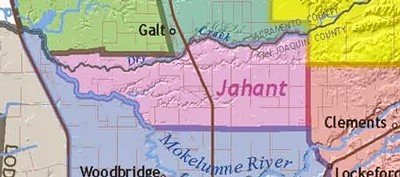
Jahant AVA
• Geographically the smallest of Lodi’s seven AVAs – comprising 28,000 acres, with 9,000 planted acres – extending west-east in the center of the Lodi AVA, bordered by Dry Creek and Peltier Road to the north and south, and located mostly in San Joaquin County.
• Name derived from Peter Jahant who, with several brothers, first settled in the area in the vicinity of Acampo during the 1850s; thereafter, lending the family name to numerous local landmarks (Jahant Slough, Jahant Rd., Jahant Equestrian Center, and several Jahant Vineyards).
• This AVA is marked by erosion in relatively flat topography with fairly consistent 10’ to 80’ elevations.
• Sits on highly desiccated river terraces and old floodplain deposits; consisting primarily of shallow, pinkish sandy clay loam in the San Joaquin Series on an indurated duripan; generally sandier at the surface with older, cemented, root restrictive layers at the sub-surface, with a few sections of deeper sandy loam.
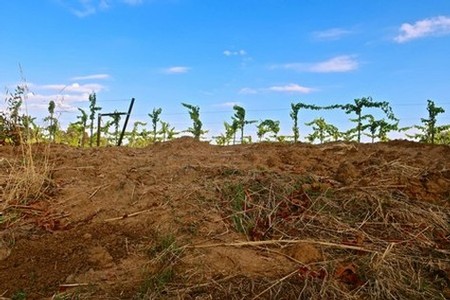
Jahant's reddish San Joaquin Series clay loam at 2-ft. depth in LangeTwins Family Vineyards
• Climate is similar to Mokelumne River AVA to the immediate south, but receives more cold air drainage and entrapment with vineyard pockets that are even cooler than most parts of Mokelumne River.
• Has lower precipitation than east side AVAs (Sloughhouse, Borden Ranch and Clements Hills); but more Delta fog influence, hence the coolest growing seasons on average (along with the Mokelumne River AVA) of the seven Lodi AVAs.
• White varieties (Chardonnay, Viognier, Sauvignon blanc) have been extensively planted over the past 25 years, although black skinned skinned grapes (Cabernet Sauvignon, Merlot, Petit Verdot, Primitivo/Zinfandel, Carignan, Petite Sirah, Barbera, Sangiovese, Tempranillo, Teroldego, Montepulciano, Nero d’Avola) are also performing well.
• Excellent examples of Jahant grown wines include LangeTwins Family Vineyards Sangiovese Rosé, LangeTwins Family Vineyards “Musqué Clone” Sauvignon Blanc, LangeTwins Family Vineyards Montepulciano, LangeTwins Family Vineyards Teroldego, Bokisch Vineyards Liberty Oaks Vineyard Tempranillo, Oak Farm Vineyards Hohenrieder Vineyard Zinfandel, and St. Amant Winery Barbera.

Mokelumne River AVA
• Lodi’s largest AVA, located on the southwest side; consisting of 85,700 acres and over 42,000 acres of planted wine grapes; bordered on the west side by Interstate 5, which also marks a dividing line before elevations dip below sea level west of the freeway (the gray areas falling within the Lodi AVA west of I-5 are at zero to minus-20’ elevations, kept dry by the Delta’s complex network of levees and waterways).
• This AVA – which houses almost all of Lodi’s wine production facilities – is centered around the City of Lodi (population 62,000); also encompassing the census-designated communities of Woodbridge, Acampo and Victor.
• Named for the river that flows from the Sierra Nevada through the AVA, originally derived from a rough translation of the Native American (Miwok) name for the area as “the place of the fish net” (Mokelumne was also the name of the community established during the 1840s on the south bank of the river, which was changed to Lodi in 1864 and incorporated as the City of Lodi in 1906).

Classic old vine Zinfandel growing in fine, white loamy sand in Steacy Ranch (east side Mokelumne River)
• Mokelumne River is the historic source of Lodi’s oldest vines; much of it own rooted, head trained Zinfandel, Carignan, and Alicante Bouschet (including Lodi’s oldest planting, the Bechthold Vineyard Cinsaut, planted in 1886 as “Black Malvoisier”), sitting alongside a larger proportion of more recent, trellised, continuously replanted vineyards.
• Since the mid-1980s, Flame Tokay – a seeded table grape that once reigned as Mokelumne River-Lodi’s dominant grape crop – has largely disappeared; clinging to life in tiny front-yard parcels as little more than curiosities.
• This region includes the lower Mokelumne River to its confluence with the Cosumnes River at the northwest corner of the AVA, and is one of Lodi’s cooler climate terroirs; its Mediterranean climate moderated by Delta breezes flowing in directly from the Bay Area and Carquinez Strait to the immediate west.
• Defined by a fairly flat topography with elevations from 10' to 85'; consisting of deep (up to 50’) alluvial fan deposits of largely young (25,000 years old) Tokay Series sandy loam with high organic content, no immediate hardpan, and slight variations (generally more porous loamy sand east of California Hwy. 99, and loamier sand with slightly more water holding capacity west of the highway and closer to the Delta).
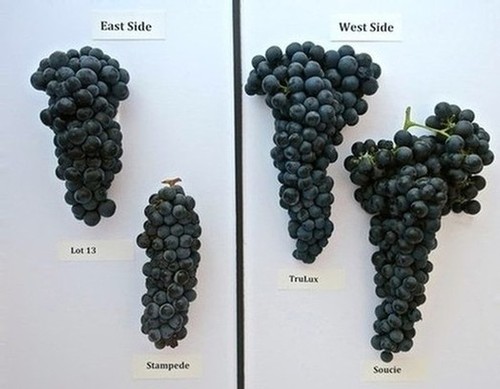
Impact of Mokelumne River terroir on Zinfandel cluster and berry sizes, and ultimately on wine characteristics: east (less vigorous, sandier loam) vs. west (higher vigor sandy loam) sides of AVA (re detailed report on Zinfandel soil and selection)
• These optimal soil attributes – plus historically, a higher water table prior to the completion of the Camanche Dam at the eastern edge of San Joaquin County in 1964 (enabling dry farming through much of Lodi’s early agricultural history) – were the reasons why this part of California Grape District 11 (i.e. San Joaquin County north of CA Hwy. 4 and Sacramento County south of Interstate 50) was the first to be extensively farmed; dominated by wheat and watermelon towards the late 1800s, followed by own-rooted grape vines (mostly Tokay as a table grape and Zinfandel as a wine grape) by the turn of the 20th century.
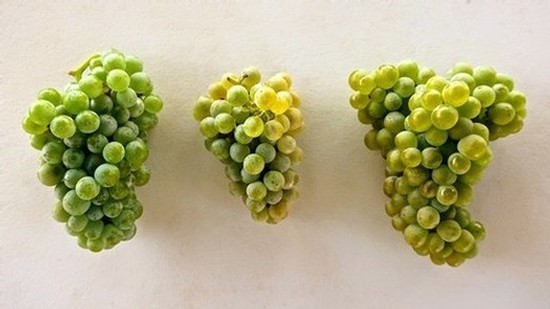
Impact of soil on soil/AVAs on Bokisch Vineyards Albariño clusters, left to right: 1) Las Cerezas Vineyard in Mokelumne River (deep, high vigor sandy loam soil leading to green skinned, healthy cluster sizes); 2) Terra Alta Vineyard in Clements Hills (shallow gravelly clay slope leading to smaller canopy/clusters with golden color and earliest ripening); 3) Andrus Vineyard in Sacramento County/Delta (highest vigor peat alluvium soil leading to larger canopy/clusters, higher yields and slower ripening); re detailed report, Impact of terroir on Bokisch grapes
• This terroir has proven conducive to both red and white wine grapes (close to 100 different varieties grown commercially); including many of the classic French, Italian and Spanish grapes, and even a good number of German cultivars.
• Excellent examples of Mokelumne River grown white wines include Harney Lane Winery Albariño, Acquiesce Vineyard Grenache Blanc, Acquiesce Vineyard Viognier, Mensch (by Covenant Wines) Roussanne, Bokisch Vineyards Las Cerezas Vineyard Albariño, Sidebar Cellars Kerner, Markus Wine Co. Mokelumne Glen Vineyards Nativo (Kerner/Riesling/Bacchus), Oak Farm Vineyards Mohr-Fry Ranches Sauvignon Blanc, and Michael David Winery Chardonnay.

Marina Holman showing some love to Flame Tokay (once Lodi's most widely planted grape) in Mokelumne Glen Vineyards
• Excellent examples of Mokelumne River grown red wines include McCay Cellars Abba Vineyard Grenache, Klinker Brick Winery Farrah Syrah, Harney Lane Winery Petite Sirah, Bokisch Vineyards Las Cerezas Vineyard Graciano, Fields Family Wines Lot 13 Vineyard Tempranillo, Oak Farm Vineyards Barbera, Peltier Winery Schatz Family Reserve Teroldego, Hatton Daniels Wine Cellars Mokelumne Glen Vineyard Zweigelt, Paskett Winery Charbono, PRIE Vineyards Mokelumne Glen Vineyards Dornfelder, Mettler Family Vineyards Pinotage, Prieta Loma Winery Bodo’s Blend (Pinotage/Petite Sirah), Maley Bros. Merlot, Inkblot (by Michael David Winery) Cabernet Franc, and Rapture (by Michael David Winery) Cabernet Sauvignon.
• For a detailed list of classic old vine (i.e. pre-1960s) Mokelumne River Zinfandel, Carignan and Cinsaut plantings and bottlings, please see our previous blog posts on Lodi’s single-vineyard wines (Part 1-west side growths and Part 2-east side growths).

Ancient vine Rauser Vineyard Alicante Bouschet (planted 1909) on the east side of Lodi's Mokelumne River AVA